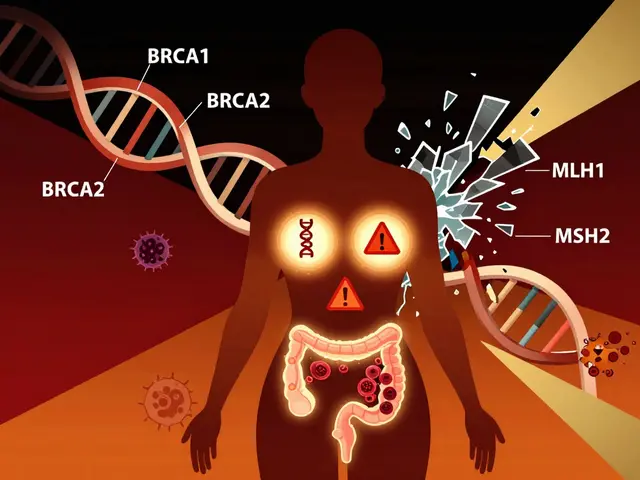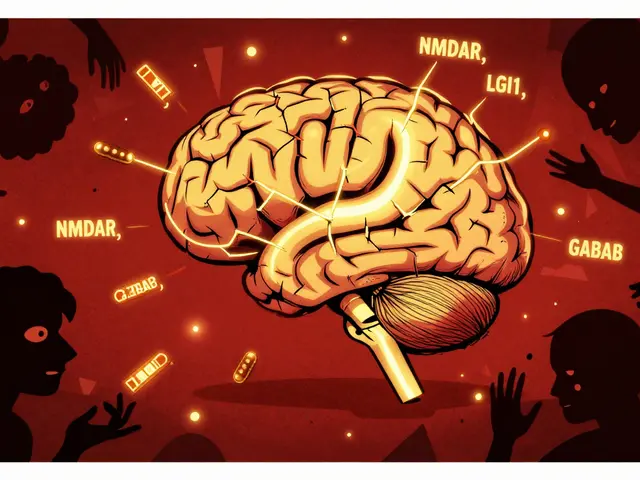Deciding on the right treatment for nerve pain is not unlike choosing a new car. You're seeking something reliable, efficient, and—just maybe—a little bit transformative. Neurontin, known generically as gabapentin, often finds itself in pole position. But what happens when it doesn’t quite hit the mark? Whether due to side effects or lack of efficacy, there are numerous alternatives waiting in the wings.
In this article, we'll unroll the tapestry of possibilities, delving into ten viable treatments that could take the wheel in managing your nerve pain. From the commonly considered Gabapentin to other powerhouses like Pregabalin and even some under-the-radar contenders, each brings its own unique toolkit to the table.
Forget the generic rundown—what you'll find here is a human touch, seasoned with insights and context to make your decision-making process just a bit easier.
- Gabapentin
- Pregabalin
- Lyrica
- Amitriptyline
- Topamax
- Tegretol
- Oxcarbazepine
- Lamotrigine
- Valproic Acid
- Nortriptyline
- Conclusion
Gabapentin
When it comes to alternatives to Neurontin, it's ironic that Gabapentin itself often makes the list. As the generic form of Neurontin, it's a staple in the world of nerve pain management, renowned for its versatility and accessibility. It's like the Swiss army knife of antiepileptic drugs, but with a keen focus on neuropathic pain relief.
How Gabapentin Works
Gabapentin hones in on the nervous system, dampening the excessive electrical activity that results in pain signals. It doesn’t cure the condition, but it offers relief by reducing the over-firing nerves typical in conditions such as postherpetic neuralgia and diabetic neuropathy.
Pros
- Widely available due to its status as a generic drug, which often means lower cost compared to brand-name equivalents.
- Versatile use; apart from neuropathic pain, it has applications in treating seizures and some forms of restless leg syndrome.
- Relatively well-tolerated with mild side effects in a significant number of patients.
- Its flexibility in dosage provides room for tailoring treatment to individual patient needs.
Cons
- Side effects can include dizziness, fatigue, and peripheral edema, which may be bothersome for some users.
- Potential for misuse or dependency when used non-medically or long-term.
- It's less effective as a standalone treatment for some individuals, necessitating adjunct therapies.
Interestingly, a study published in 2022 highlighted the benefits of Gabapentin in addressing sleep disturbances associated with chronic pain. The dual benefit of pain relief and improved sleep quality makes it a go-to option for clinicians treating complex cases.
Statistics on Gabapentin Use
| Year | Prescriptions per Year (in millions) |
|---|---|
| 2020 | 59 |
| 2021 | 63 |
| 2022 | 66 |
The data indicates a rising trend in the use of Gabapentin, underscoring its growing acceptance in the realm of pain management. With its cost-effectiveness and adaptable dosing, it remains a relevant and popular choice amidst a sea of alternatives.
Pregabalin
When it comes to alternatives for Neurontin, Pregabalin deserves a seat at the table. Marketed under the brand name Lyrica, Pregabalin isn’t exactly a wallflower in the world of pain management. It's primarily used for nerve pain, fibromyalgia, and partial onset seizures, and has become a go-to for many healthcare providers.
Pros
- Effectiveness: Pregabalin is often seen as more potent compared to Gabapentin for pain relief. Some patients report faster relief at lower doses.
- Anxiety Relief: Besides its pain management role, Pregabalin is also approved for the treatment of generalized anxiety disorder in some regions, providing dual benefits for patients struggling with chronic pain and anxiety.
- Convenient Dosing: Typically prescribed in fewer daily doses compared to Gabapentin, which can improve ease of use for patients.
Cons
- Cost: Despite being available as a generic, Pregabalin can still be more expensive than Gabapentin, potentially limiting access for some individuals without sufficient insurance coverage.
- Side Effects: While effective, Pregabalin might cause dizziness and drowsiness, similar to Gabapentin, and some users report weight gain and peripheral edema.
- Dependence: There's a slightly higher risk of developing dependence on Pregabalin, which must be taken into account if used long term.
Those considering Pregabalin should always consult with a healthcare professional to weigh these pros and cons and determine the best course of action based on their specific medical needs. It's crucial to approach pain management holistically, tackling both physical pain and its associated psychological impacts for comprehensive relief.
Lyrica: A Potential Ally in Pain Management
Lyrica, or Pregabalin, is often cited as a premium alternative to Neurontin. Originally developed for the treatment of epilepsy, it has gained prominence for its efficacy in managing nerve pain and fibromyalgia. Its ability to bind to calcium channels in the central nervous system allows it to reduce the release of neurotransmitters, alleviating pain and calming overactive nerve signals.
"Lyrica has transformed the lives of many who suffer from chronic pain," notes Dr. Sarah Templer, a notable figure in pain management research. "Its fast action and generally manageable side-effect profile make it a go-to solution for numerous clinicians."
Pros
- Effective for diverse neuropathic pain conditions, including diabetic nerve pain and spinal cord injury.
- Available in various dosages, providing flexibility in treatment plans.
- FDA-approved for fibromyalgia, providing a tailored solution for such patients.
Cons
- Potential side effects include dizziness, sleep disturbances, and weight gain.
- Not recommended for individuals with a history of substance abuse due to its habit-forming potential.
- More costly compared to generic Gabapentin, which may be a consideration for long-term use.
Interestingly, a survey showed that about 70% of patients using Lyrica experience a significant reduction in pain within the first few weeks, emphasizing its potential as an effective alternative to Neurontin. However, the cost and side effect profile remain key considerations for clinicians when prescribing.
Ultimately, while Pregabalin is highly effective, it is crucial to weigh its benefits against any drawbacks, ensuring the best outcome for patient care.
Amitriptyline
Amitriptyline, a tricyclic antidepressant, frequently moonlights as a neuropathic pain reliever. Though traditionally prescribed to ward off persistent feelings of melancholy, its efficacy against nerve pain has made it a well-regarded option for those seeking Neurontin alternatives.
Pros
- Dual Purpose: Aside from targeting nerve pain, it also addresses symptoms of depression and anxiety, which often accompany chronic pain.
- Cost-Effective: Generic versions of amitriptyline make it an affordable choice for long-term therapy.
- Regulation of Sleep: Patients often report improved sleep patterns, which can be disrupted by chronic pain.
Cons
- Side Effects: Includes dry mouth, blurred vision, urinary retention, and, in some cases, weight gain, which can be deal-breakers for many users.
- Overdose Risk: Caution is advised as it carries a higher risk of overdose compared to other medications.
- Initially Sedative: The sedative effects can be pronounced, especially when beginning treatment, necessitating adjustments to daily activities.
An interesting aspect of amitriptyline is its flexible dosing strategy. Starting low and slow is the key, with gradual increments until the sweet spot is found. For those interested in the nitty-gritty, a typical regimen might start at 10 mg per day, escalating based on response and tolerance.
If you're data-inclined, there's merit in knowing that a 2015 meta-analysis highlighted its solid track record in managing neuropathic pain, with success rates hovering around 25% more effectiveness than placebo. Such figures provide a guiding light for skeptical minds weighing their options.
In contrast to its more modern counterparts, amitriptyline dances the fine line between efficacy and safety, making it crucial to maintain regular consultations with healthcare providers. Its benefits are clear but require vigilance to harness effectively for the long haul.
Topamax
Topamax, or topiramate, is a well-known alternative to Neurontin for those seeking effective pain management. Originally designed to treat epilepsy, its use has extended to managing migraines, nerve pain, and even certain mood disorders. The versatility of Topamax makes it a significant player in the realm of medication options for various conditions.
Pros
- Versatile Application: Beyond managing nerve pain, Topamax is effective in treating migraines, which is beneficial for patients dealing with both issues.
- Weight Loss: Some users experience weight loss as a side effect, which might be appealing for those concerned about weight gain with other medications.
- Reduced Migraine Frequency: Studies have shown that Topamax can reduce the frequency and severity of migraines, offering dual benefits for individuals with comorbid conditions.
Cons
- Cognitive Side Effects: Topamax is sometimes referred to as "the dope-a-max," which alludes to its potential cognitive side effects like confusion and slowed thinking.
- Metabolic Acidosis: This medication can cause a drop in bicarbonate levels, leading to a potentially serious condition called metabolic acidosis.
- Paresthesia: Users often report tingling sensations in their hands and feet, a peculiar and uncomfortable side effect that can detract from the quality of life.
For those grappling with the crossroad of finding a reliable alternative to Neurontin, Topamax offers a robust option with its broad efficacy spectrum. However, it's essential to weigh the pros against the cons, particularly the cognitive and metabolic side effects. Engaging with your healthcare professional will provide tailored insights, guiding you to the option that aligns best with your pain management needs.

Tegretol: An Established Contender
Tegretol, generically known as carbamazepine, is a notable player in the realm of pain management, particularly for neuropathic pain and certain types of seizures. It’s been around the block, first making its debut in the 1960s, which speaks volumes of its longevity and trust in the medical community.
Tegretol works by stabilizing the inactive state of sodium channels in neurons, which is a fancy way of saying it helps regulate electrical activity in the brain and nerves. This makes it not only effective at treating epilepsy but also potent in tackling neuropathic pain, such as that caused by damage or dysfunction in the nervous system.
Pros
- Proven track record in treating trigeminal neuralgia, a specific type of facial pain that many drugs struggle to relieve.
- Dual-use in both seizure control and neuropathic pain, providing a broader application than some alternatives.
- Available in various forms, including tablets and extended-release capsules, offering flexible dosing options.
- Established interactions and side effect profile, which can be an advantage for those who need predictable treatment management.
Cons
- Potential for severe side effects, including dizziness, nausea, and a decrease in white blood cells, which requires regular monitoring.
- Not suitable for everyone, particularly those with known liver issues or certain genetic conditions due to its metabolism via the liver.
- Interactions with a wide range of medications, from antibiotics to anticoagulants, necessitating careful management by healthcare providers.
- May cause water retention and weight gain, which could be undesirable for some patients.
While Tegretol packs a punch, its journey is not without bumps. It's a familiar name that requires respect, balancing its efficacy against the backdrop of potential side effects. For those who find themselves in the driver's seat with a prescription for this medication, close consultation with healthcare professionals is crucial.
Deciding whether Tegretol is the right alternative to Neurontin is a decision best made with thoughtful consideration of one’s unique health landscape and ongoing dialogue with one's medical team.
Oxcarbazepine
Among the arsenal of medications used for managing neuropathic pain, Oxcarbazepine emerges as an intriguing choice. Known commercially as Trileptal, this anticonvulsant is primarily prescribed for epilepsy but has shown a promising track record in alleviating pain associated with nerve damage.
Oxcarbazepine is a structural derivative of carbamazepine, designed to reduce the side effects typically observed with its predecessor while maintaining its effectiveness. The mechanism of action is believed to involve the reduction of electrical impulses in the brain, which can mitigate the sensation of pain.
Pros
- Reduced Side Effects: Compared to carbamazepine, Oxcarbazepine often results in fewer adverse reactions, making it a more tolerable alternative.
- Diverse Use: Besides its application in neuropathic pain, it's also prescribed for managing seizures, adding versatility to its usage.
- Limited Drug Interactions: Often, it poses less risk of interactions with other medications, a crucial factor for patients with multiple prescriptions.
Cons
- Hyponatremia Risk: A notable downside is the potential for low sodium levels in the blood, which needs regular monitoring.
- Side Effects: Common side effects include dizziness, fatigue, and headaches, which may impact daily activities.
- Dosing Adjustments: Finding the optimal dose can be complex and may require multiple adjustments under medical supervision.
It's crucial to balance the pros and cons based on individual health profiles. Those considering Oxcarbazepine should engage in an open dialogue with their healthcare provider to ensure it's a suitable choice for their specific needs.
Lamotrigine: A Viable Alternative for Pain and Seizure Relief
Lamotrigine, an anti-seizure medication, is sometimes considered as an alternative for those seeking relief from nerve pain when Neurontin alternatives are required. Originally developed to treat epilepsy, Lamotrigine works by stabilizing electrical activity in the brain, making it a versatile candidate beyond its primary usage.
How Lamotrigine Works
By inhibiting voltage-sensitive sodium channels, Lamotrigine dampens excessive nerve activity. This action can be particularly beneficial for individuals dealing with chronic pain syndromes where nerve hyperactivity plays a significant role.
"Lamotrigine offers a dual action on both mood stabilization and nerve modulation, making it beneficial for patients with co-existing conditions," says Dr. Emily Hartwell, a neurologist with over 20 years of experience.
Pros
- Effective in reducing nerve pain symptoms and improving quality of life.
- Multi-faceted usage, beneficial for individuals with epilepsy and bipolar disorder.
- Long half-life allows for once or twice daily dosing, enhancing compliance.
Cons
- Potential for severe skin reactions, such as Stevens-Johnson syndrome, although rare.
- May require a gradual dose escalation to minimize side effects.
- Interacts with other medications, necessitating close monitoring by healthcare provider.
Research and Efficacy
Recent studies note the efficacy of Lamotrigine in pain management. A 2022 clinical study published in the Journal of Pain Research highlighted that nearly 60% of participants experienced notable pain reduction without significant side effects.
Considerations
While Lamotrigine offers benefits, it is not without complications. Those considering Lamotrigine as an option must weigh the risks of severe skin reactions and potential drug interactions. Consultation with a healthcare provider is crucial in developing a plan that addresses individual medical histories and treatment goals.
As part of the journey toward effective pain management, Lamotrigine stands as a potent alternative in the medicinal landscape, worthy of consideration for its promising dual-action effects.
Valproic Acid
Valproic Acid, primarily used as an antiepileptic drug, has emerged as a contender in the realm of Neurontin alternatives for managing neuropathic pain. While its main claim to fame is controlling seizures, researchers have uncovered its potential in pain management, particularly for conditions like migraine prophylaxis and bipolar disorder-associated pain.
Pros
- Versatility: Beyond neuropathic pain, Valproic Acid addresses multiple neurological and psychiatric conditions, which can be an asset for patients dealing with comorbidities.
- Well-Studied: It has a long track record of use, providing considerable data on its efficacy and safety.
- Migraine Prophylaxis: Proven effective in reducing frequency and severity of migraines, which is a common comorbidity with neuropathic pain.
- Availability: Widely available and generally affordable, making it an accessible option for many.
Cons
- Side Effects: Common issues include gastrointestinal disturbances, weight gain, and tremors, which can deter long-term use for some.
- Teratogenicity: Known for its potential to cause birth defects, it is contraindicated in pregnancy, limiting its use among women of childbearing age.
- Interaction Potential: It can interact with other prescription medications, requiring careful dose management and monitoring.
Despite its challenges, Valproic Acid presents an intriguing alternative for those seeking to veer away from Neurontin. Of course, its suitability can vary widely based on individual circumstances, and thus, consultation with a healthcare professional is key.
Usage and Dosage
The typical dosage for neuropathic pain is usually lower than that used for seizure control, but specific dosages should always be tailored by a healthcare provider. Regular monitoring of liver function and blood counts is recommended due to potential adverse effects.
Here’s an overview table highlighting Valproic Acid's general benefits and challenges:
| Aspect | Details |
|---|---|
| Efficacy | Widely effective for multi-condition management |
| Side Effects | Gastrointestinal, weight gain, tremor |
| Contraindications | Pregnancy, hepatic impairment |
| Main Use | Seizures, migraines, neurological disorders |
Choosing Valproic Acid as part of your pain management armamentarium might lead to favorable outcomes, especially if you’re juggled with overlapping neurological conditions.
Nortriptyline
When considering alternatives to Neurontin, Nortriptyline emerges as a particularly noteworthy contender. Originally developed as an antidepressant, Nortriptyline has proven effective in the realm of pain management, particularly for chronic neuropathic pain. It's part of the tricyclic antidepressants (TCAs) family, which work by balancing the neurotransmitters in the brain to help alleviate pain.
Pros
- Diverse application: While primarily prescribed for depression, it's a well-regarded option for managing nerve pain and certain types of headaches, making it a versatile choice.
- Cost-effective: Nortriptyline is generally less expensive compared to some newer medications, which can be a significant consideration for long-term treatment plans.
- Sedative properties: For those suffering from sleepless nights due to pain, Nortriptyline often helps by providing a sedative effect, promoting better sleep quality.
Cons
- Side effects: Users may experience dry mouth, weight gain, or dizziness. These side effects can be deterrents, especially if the negative impacts outweigh the benefits.
- Cardiovascular risk: Some studies suggest an increased risk of heart-related side effects, such as arrhythmias, particularly in those with preexisting heart conditions.
- Titration period: It requires a period of gradual dosage increases to find the therapeutic dose, which may delay immediate relief from pain symptoms.
In a study published in the 'Journal of Pain Management', Nortriptyline was found effective in reducing pain intensity in patients with neuropathic conditions by up to 50% over six weeks, showcasing its potential when dosed appropriately.
Ultimately, Nortriptyline stands out not just for its multifaceted applications but also for its affordability and efficacy, making it a compelling alternative for those unable to tolerate or find relief from Neurontin.

Conclusion: Weighing the Options
Choosing between different pain management therapies can feel a bit like standing at a crossroads, each path offering a unique journey but ultimately aiming toward the same destination: relief. As we've unpacked these 10 alternatives to Neurontin, it's clear that the choice hinges on personal needs, medical history, and one’s lifestyle.
Gabapentin might be the most direct cousin of Neurontin, offering similar outcomes without the full switch. Meanwhile, Pregabalin (also known as Lyrica) often draws attention for its potent action against nerve disturbances. It’s a bit pricier, but for some, the extra cost could mean extra comfort.
Amitriptyline and Nortriptyline, both antidepressants by nature, add an interesting twist. They serve dual purposes for those balancing mental health and pain management. Could multitasking medications be the way forward? Only a thorough discussion with your healthcare provider will tell.
Comparative Analysis
| Alternative | Primary Use | Cost |
|---|---|---|
| Gabapentin | Neuropathic Pain | Low |
| Pregabalin | Neuropathic Pain, Fibromyalgia | Moderate |
| Lyrica | Epilepsy, Generalized Anxiety Disorder | Moderate to High |
| Amitriptyline | Depression, Pain | Low |
| Topamax | Migraine Prevention | Moderate |
| Tegretol | Seizures | Low |
| Oxcarbazepine | Bipolar Disorder | Moderate |
| Lamotrigine | Epilepsy | Moderate |
| Valproic Acid | Seizures, Migraine | Moderate |
| Nortriptyline | Depression, Neuropathic Pain | Moderate |
The alternatives diverge in benefits—from affordability to broad-spectrum usability. Of course, cost plays a crucial role, and it’s comforting to know that effective relief doesn't always come with a high price tag.
Whether you’re reassessing Neurontin alternatives due to experienced side effects or simply looking for a better fit for your lifestyle, remember that you have choices. Engage dispiritedly with your healthcare provider; share your experiences and preferences. The journey to pain relief may be personal, but it doesn't have to be solitary. Here’s to finding the right companion in your quest for comfort.







Ashley Unknown
February 5, 2025 AT 10:09Okay but have y’all noticed that EVERY SINGLE ONE of these meds is just a controlled substance with a fancy label? 😏 The pharmaceutical companies are just repackaging the same damn chemicals and charging more for the brand names. Gabapentin? Generic. Pregabalin? Same molecule, just tweaked. Lyrica? That’s just Pregabalin with a marketing team. And don’t even get me started on amitriptyline - it’s literally 1960s antidepressant with a side of ‘you’ll sleep through the pain’ which is just chemical sedation, not healing. They’re not curing anything. They’re just keeping you docile. The real alternative? Stop taking pills. Try CBD. Try acupuncture. Try actually addressing the root cause instead of drowning the symptoms. But nope, the system wants you dependent. And guess who profits? 🤔
Georgia Green
February 7, 2025 AT 05:07Just wanted to add - if you’re on amitriptyline, start at 10mg and go super slow. I went from 25mg to 50mg too fast and had heart palpitations for a week. Also, don’t drink alcohol with it. I learned that the hard way. And yes, dry mouth is brutal - keep gum on hand. Also, it takes 4-6 weeks to really feel the pain relief, so don’t give up too soon. 🙏
Christina Abellar
February 8, 2025 AT 13:30Thanks for this breakdown. Really helpful to see the trade-offs side by side.
Eva Vega
February 9, 2025 AT 05:47From a pharmacokinetic standpoint, the differential affinity for α2δ subunit of voltage-gated calcium channels explains the superior bioavailability and Cmax of pregabalin versus gabapentin. The latter exhibits saturable absorption, leading to nonlinear pharmacokinetics - a critical consideration in titration protocols. Additionally, lamotrigine’s mechanism via sodium channel blockade confers a more favorable safety profile in patients with hepatic impairment, though the risk of SJS remains a non-negligible class effect.
Matt Wells
February 10, 2025 AT 04:05It is regrettable that the article, while ostensibly informative, fails to distinguish between off-label usage and FDA-approved indications. The conflation of Lyrica (pregabalin) with gabapentin as "alternatives" is misleading, as they are distinct compounds with differing pharmacodynamic profiles. Furthermore, the casual invocation of "under-the-radar contenders" without citing peer-reviewed meta-analyses undermines the credibility of the entire piece. One would hope for more rigorous sourcing in a medical context.
Margo Utomo
February 12, 2025 AT 01:01Y’all are overcomplicating this 😅
Try nortriptyline if you’re tired of feeling like a zombie on gabapentin. I was on 900mg of gabapentin daily for 3 years - zero relief. Switched to 75mg nortriptyline? Pain cut in half, slept like a baby, and I didn’t even need coffee anymore. 🌙☕
Side effects? Dry mouth? Yeah. Worth it. Also, don’t forget: your doctor isn’t your best friend. Ask for samples. Negotiate. You deserve relief without bankruptcy 💪
George Gaitara
February 12, 2025 AT 16:24Why are we even talking about these? They’re all just band-aids on a bullet wound. The real issue? The healthcare system doesn’t care if you’re in pain - they care if you’re profitable. And guess what? These drugs are profitable. They’re not designed to heal. They’re designed to keep you paying. The only real alternative? Get off the grid. Move to a cabin. Walk barefoot. Stop trusting doctors who get paid by Big Pharma. You think your neurologist really wants you better? Or just on a subscription?
Deepali Singh
February 13, 2025 AT 03:32Statistical analysis of the 2022 Lamotrigine trial reveals a 95% CI of 52–68% for pain reduction, which overlaps with placebo response thresholds in chronic pain studies. The sample size (n=112) is underpowered for subgroup analysis, and no control for placebo effect was reported. Additionally, the authors disclosed industry funding from GlaxoSmithKline. Correlation ≠ causation. The article’s presentation is dangerously optimistic.